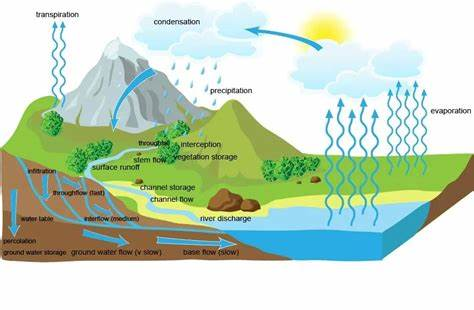Hydrological cycle summary
closed system
driven by solar energy +GPE
GPE turns into KE to allow the water to move on the surface

blue water - water stored in rivers, streams, lakes + groundwater in liquid form (visible)
- accessible
green water - water stored in soil + vegetation (invisible)
stores - areas of the earth where water is held
cryosphere - areas of the earth where water is frozen into snow or ice
residence time - the avg. amount of time a water molecule will stay in a store
- stores w/ a longer turnover are more vulnerable to pollution
- fossil water - water that is stored underground + takes a long time to replenish
-- ancient, deep groundwater from former pluvial (wetter) periods
aquifer - groundwater store
fluxes - the rate of flow between stores
- the major fluxes are driven by precipitation, evaporation, cryosphere exchange + run off generation
- impact of geology on fluxes:
-- soil texture - (sand, silt, loam, clay) - also influences soil porosity w/ sandy soils having infiltration capacity at 3-12mm/hr vs less permeable clays at 0-4mm/hr
-- Compacted surfaces inhibit infiltration capacity at around 10mm/hr, especially when rain splash impact occurs (nature of soil surface + texture)
processes - the physical mechanisms that drive the fluxes of water between stores
evapotranspiration - water is transferred from the land to the atmosphere by evaporation from the soil and other surfaces and by transpiration from plants
percolation - the mvmt of water from the soil to (permeable) rock
infiltration - the mvmt of water from the ground surface to the soil
infiltration + percolation = both vertical movements
infiltration capacity - the maximum rate at which rain can be absorbed by a soil
- dependent on the duration of rainfall, soil porosity, vegetation cover, raindrop size, slope angle, antecedent soil moisture antecedent - previous existing conditions
residence time - the avg. amount of time a water molecule will stay in a store
- stores w/ a longer turnover are more vulnerable to pollution
- fossil water - water that is stored underground + takes a long time to replenish
-- ancient, deep groundwater from former pluvial (wetter) periods aquifer - ^^groundwater^^ store
global water budget - the annual balance of water fluxes + size of water stores
convection rainfall - land becomes hot, the air above it warms, expands + rises, as it rises the air cools + its ability to hold water vapour decreases. Clouds form + as the air rises, rain falls.
- COMMON IN TROPICAL AREAS
orographic rainfall - when warm, moist air from the Atlantic Ocean rises up over mountains. When the warm air rises, it cools and condenses to form clouds, which brings rain. Once the air has passed over the mountains, it descends and warms. This creates drier conditions known as a rain shadow
cyclonic/frontal rainfall - warm air (less dense) is forced to rise over cold air. As it rises, the air cools + condensation occurs to form clouds. As the air rises, rain falls.
rain shadow - a dry area on the downward side of the mountain, it receives little rainfall as the mountains shelter it from the rain. The air without much water is then drawn over the mountain where it descends + is warmed adiabatically by compression.